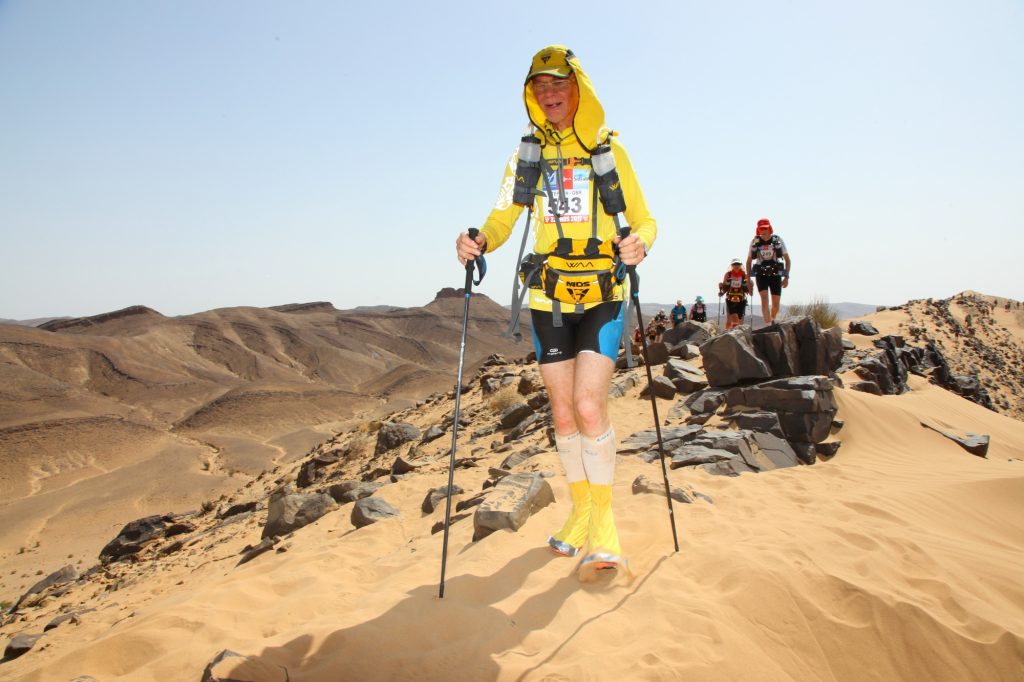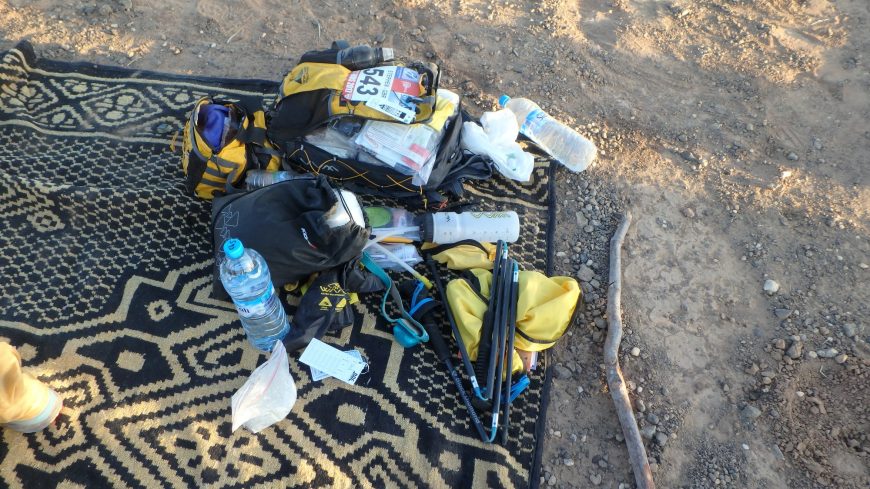
This article takes you on a deep dive into the stuff I used on my two 250km 7 day Marathon des Sables (MDS) foot races in the desert. When I started writing it, I was preparing to compete in my 3rd MDS starting in April 2022. A stress fracture (I am 65!) of my pelvis, picked up in training, has unfortunately forced me to cancel.
The following is based on my 20 year experience of endurance sport including two full 250km MDS races in Morocco and Peru.
Simple Running
I have been running marathons and the like for nearly two decades even though I didn’t actually start till I was 46. One of the many aspects I have always liked about running is the simplicity. You don’t actually need anything.
You don’t even need shoes. For a while I tried barefoot running which is much harder than it sounds. Barefoot running is all about landing on your toes and letting your Achilles tendon take the impact rather then your joints. It’s a different world to running with shoes. I even bought special Vibram 5 toe shoes to protect my soles as they quickly began to suffer. The longest I ever ran barefoot was 10km around an enormous lake near Perth, Western Australia.
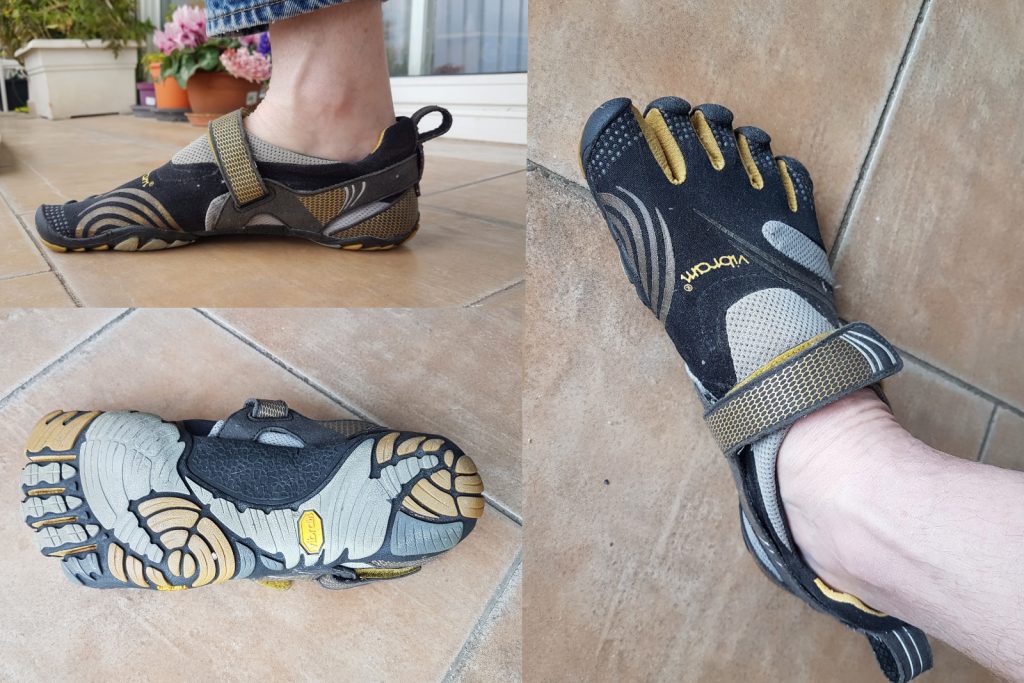
Normally though, you need at least proper running shoes and some sports clothes but that’s all. Simple – love it. I was the same with skiing. Having learnt to ski, I then tried snowboarding and it was magic. No poles, no funny boots you can’t walk in, just comfy boots and a snowboard. Happiness. Well that was fine till I started breaking bones – usually due to being crashed into rather than making mistakes on my own. My last time on a board involved wrist protectors, back protector and a helmet. All very sensible but, for me, they took the simple pureness out of boarding.
So running is simple – compared to what, I hear you ask. Well my other sporting passion is long distance Ironman triathlon. This requires a whole other level of stuff. Triathlon starts with a swim, usually in a cold sea, so a swimming wetsuit is needed as I am usually in the water for 1 or 2 hours. Then it’s a long bike ride, so a bike is needed along with bike shoes and a helmet. The race ends with a run so I need my usual running shoes as well. Add all that together then throw in bike spares, pump, hi energy foods etc and you end up with quite a stack.
Strangely I didn’t find a proper photo of the Ironman equipment but I did find the one below of our room during the 2018 Ironman 70.3 at Cascais in Portugal. My open plan organising gives you some idea of the volume of stuff I take.
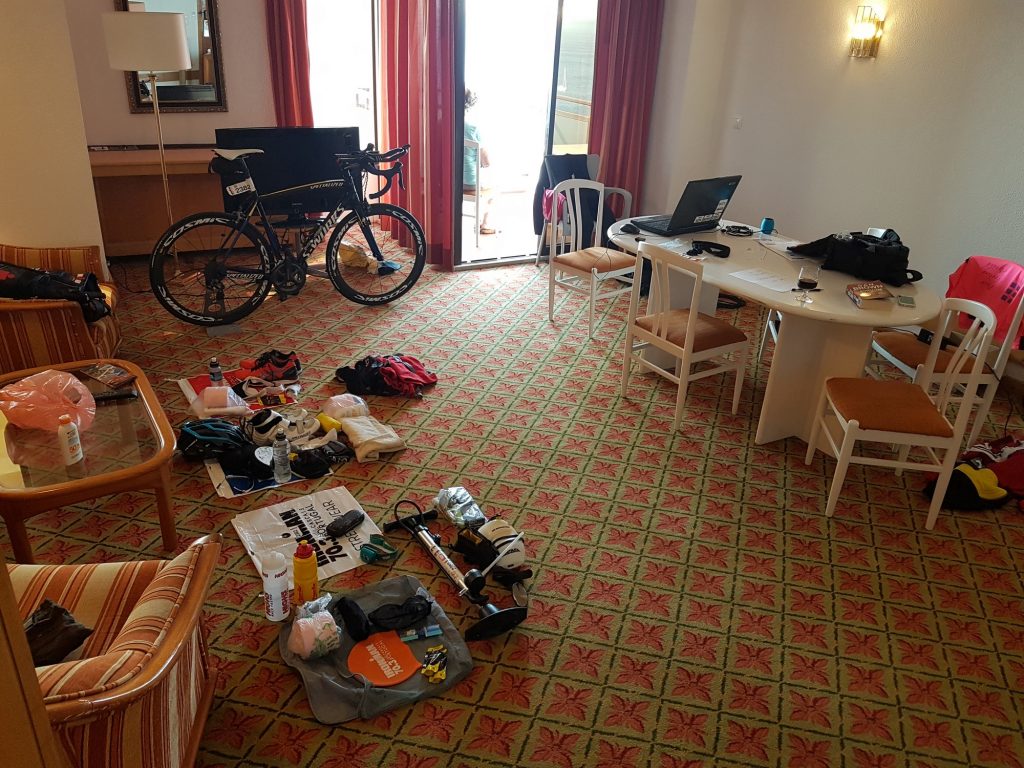
I have never dared to fly to a triathlon as boxing the bike and hoping it doesn’t miss the flight has always put me off. I have done loads of triathlons in other countries but always ones we could drive to in our enormous car. The bi product of this has been some tremendous road trips to places like Belgium, Greece, Spain, Portugal, Mallorca and Morocco.
By contrast I have flown to both the Paris and Rome marathons taking just my running shoes in hand luggage. But I digress.
Marathon des Sables
Well it’s true the MDS is just a run. But a run like no other. It’s sort of a cross between a camping holiday and a run. For 7 days you simply sleep, eat and run. How pure is that? There are two concepts here that produce all the problems: camping and 7 days. Four issues immediately come to mind: tent, toilets, water and food.
MDS Tent
The biggest requirement for any camping trip is of course the tent. Well the good news here is the tent is provided by the organisation and they carry it each day between sites. In the case of the Morocco MDS I am being a little over generous when I say “Tent”. In fact the MDS tent can better be described as carpeted shade. It’s more of a big black blanket and a few poles. In the Peru MDS we had totally standard one man tents with zips, ropes, poles and the usual stuff. For all its simplicity the Morocco tent is wonderfully functional and very comfortable until a sand storm blows in.
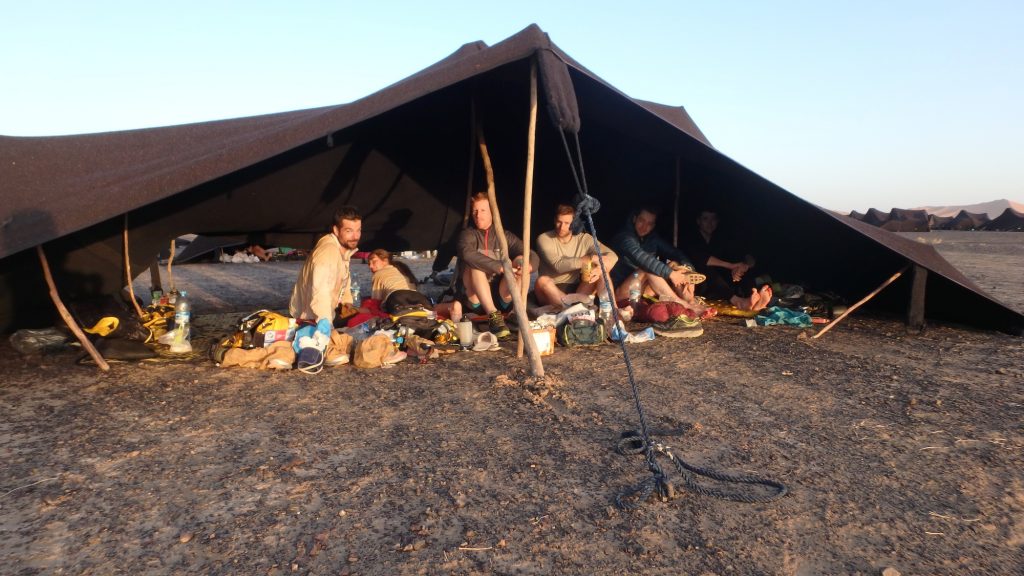
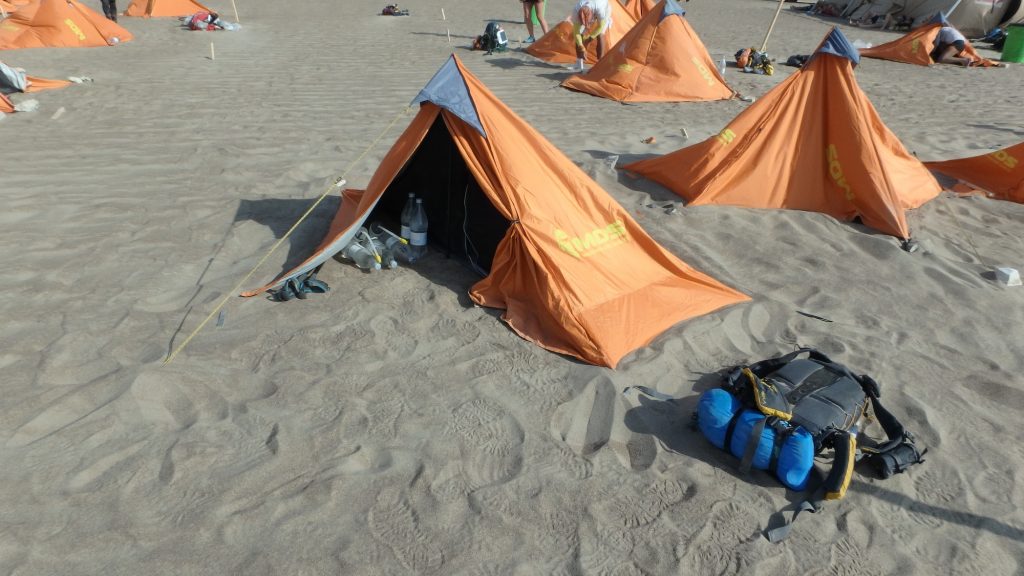
MDS Toilets
Between the MDS and all sorts of off road 4×4 rallies I have spent a considerable time in the desert in the past few years. The desert is really big and really sandy. Finding space and privacy for a quick poo is generally not a problem. Find a little slope, dig a little hole and off you go. Remember to burn the used toilet paper before you cover it all over with sand.
The industrial scale of the MDS bivouac makes this solution totally impractical of course. With their vast experience of running these events comes an elegant solution. Private cabins (built from simple poles and plastic), a seat with a hole and a roll of plastic bags. Stretch a bag over the seat, drop some sand in to make it hang right (best to select your sand before entering the toilet), then do your business. Afterwards simply close the bag and drop it in the nearby bin. I guess when we leave the bivouac they make a big bonfire. Never actually looked back though.


Desert Water
As you can imagine water is a big deal in the desert. Luckily the organisation have this well covered. Depending on the stage each athlete is supplied with up to 15 litres of water per day. The water comes in 1.5 litre bottles. Each bottle and top is marked with your race number so any littering in the desert can be penalised. During the race stages there is usually a service point every 10 to 15km where you are offered 1 or 2 bottles.
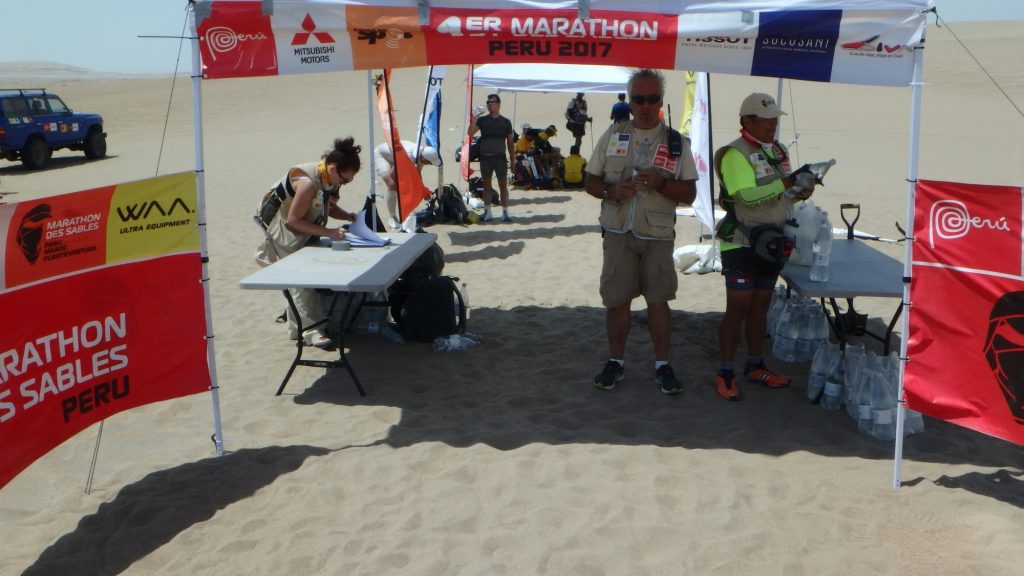
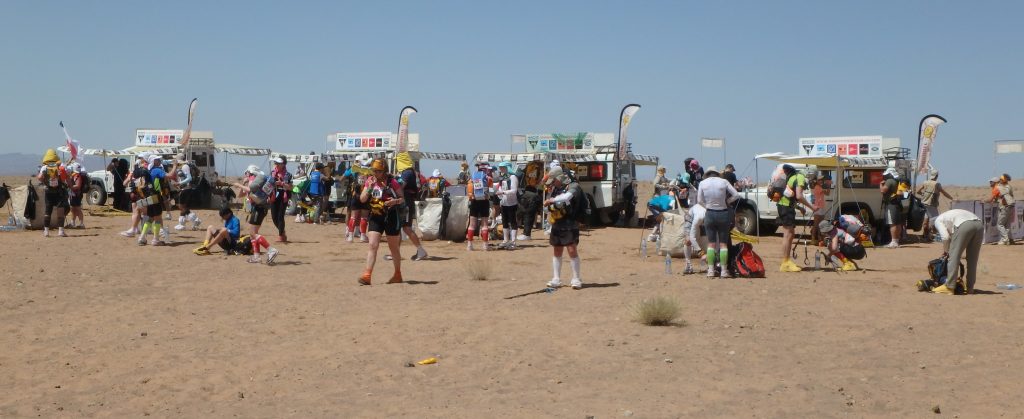
At the finish line of each stage you are given 4 or 5 bottles which will keep you watered until the first service point in the next day’s stage. Strangely enough all the water supplied in Peru had bubbles. Exotic when in a restaurant but a little odd when used for dehydrated meals, washing and teeth cleaning.
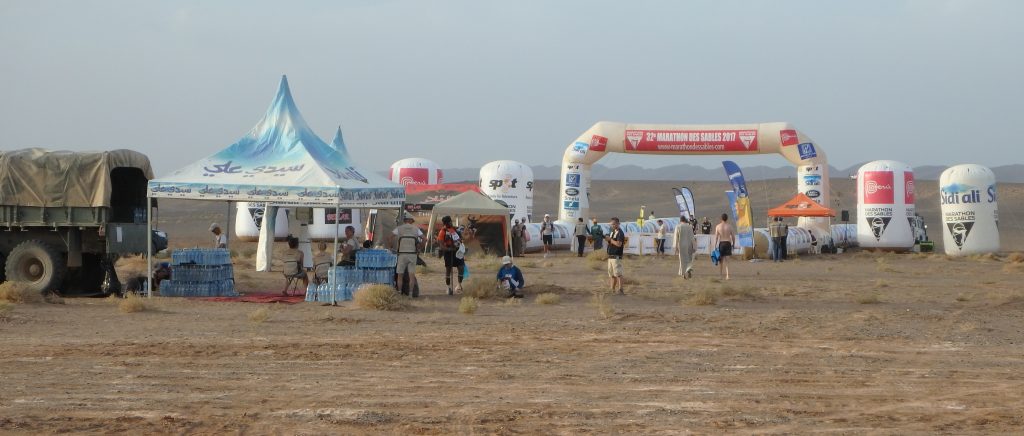
When I was in Peru it was mostly around 40C and windy, in Morocco temperatures regularly hit 50C in the dunes. Running and jogging in this environment is a massive challenge on your body’s systems. Dehydration is lurking over every dune. For me, Morocco was OK but Peru was almost a disaster.
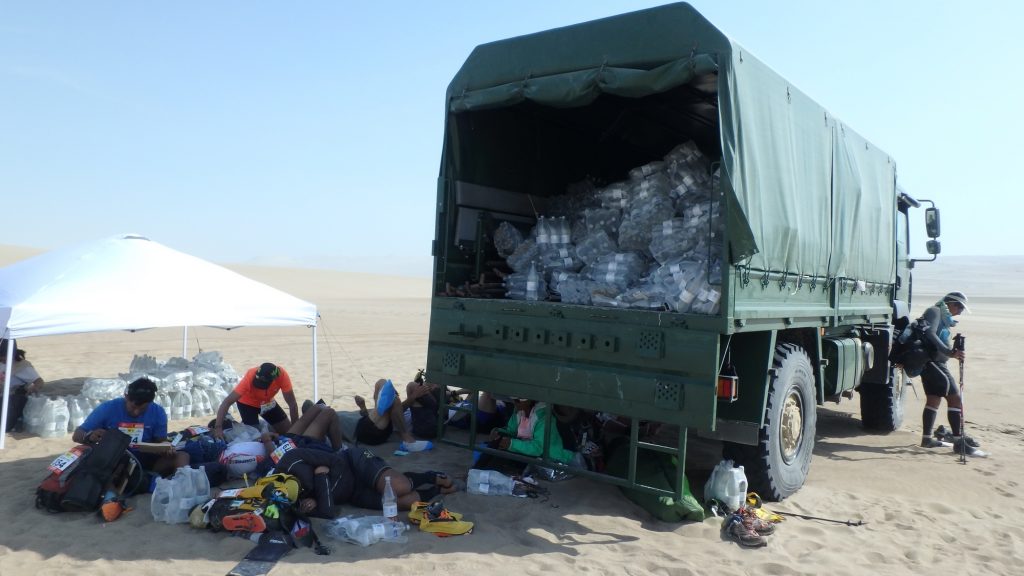
Morocco was my first MDS so I was very, very careful. I literally drank every 15 minutes like clockwork. I knew that if I became thirsty it would be too late. I tried the same in Peru but it went a bit wrong. The first 14km of the first stage in Peru was on a hard mostly downhill track, it was cloudy and windy. I was feeling fine at the service point so I only took one of the two bottles on offer.
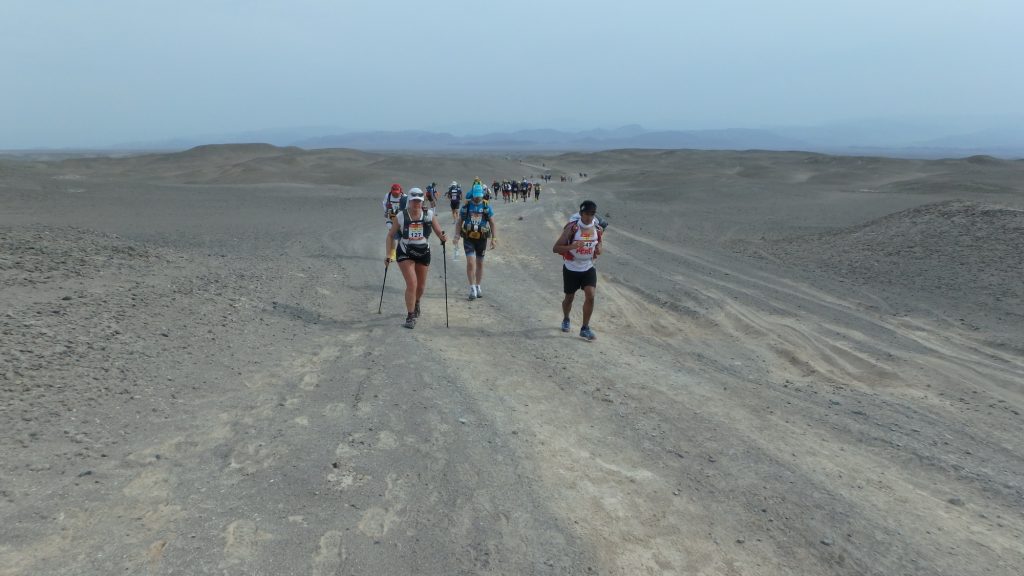
The next 14km was very hard going along a dry riverbed full of rocks and soft sand. At the 28km service point only one bottle was on offer. I ran dry well before the stage end at 37km. Arriving at the bivouac I was feeling light headed and I knew I was in trouble so headed straight for the medical tent.
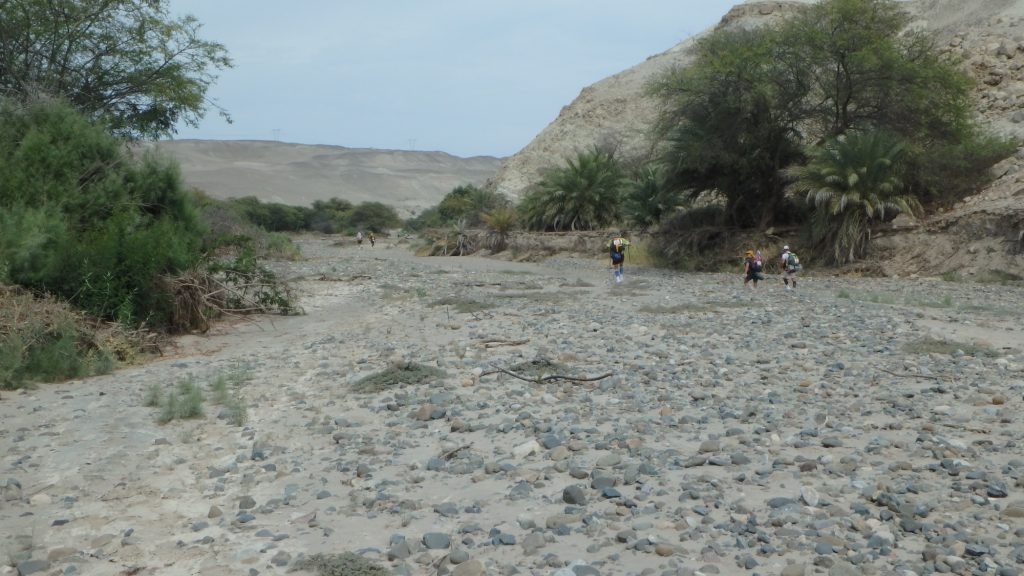
The medical tent was like a war zone, everywhere there were camp beds with dehydrated athletes on intravenous drips – I was not the only one who had mucked up. Looking back on it I suspect it was an organisation error by not offering us two bottles at the second service point. Anyhow I talked with the doctor and he told me, a) they were very short on space and b) if I accepted a drip I would get a 1 hour penalty on my time. Well that was it for me, forever the racer I didn’t need extra penalties so I headed back to my tent. I spent the rest of the day and evening sipping small amounts of water every 10 minutes. Just over 300 athletes started Stage 1. Just over 200 athletes started Stage 2. Dehydration and the generally tough course took out one third of the field on the first day.
Food
Well now the fun starts. So far everything has been supplied by the helpful organisation. That just stopped. For food and everything else you are well and truly on your own.
To avoid any confusion the organisation’s rules require you to have 2,000 calories per day. At check-in, on day 0, you have to be able to prove this by having all the contents’ panels from all the various foods you have packed. Luckily you don’t have to keep these with you; it’s just for check-in.
We are in the desert for 7 days so that means having a minimum of 14,000 calories on day one. All this, except breakfast before Stage 1, has to be carried while running so weight is really important. As you would expect all the meals are in dehydrated form. I took the following photo in 2017 when preparing for the Peru MDS. This is my choice for one day of food.

Top center: Breakfast. 125g of normal Alpen with 50g of powdered milk. Calories: 719
Top left: Lunch. 4 x 55g packets of Complan dehydrated meals. Calories: 976
Upper Center: Snacks. 120g of Peanuts. Calories: 742
Top right: Evening Dessert and below it is my evening meal. Both are dehydrated and weigh in at 100g and around 130g. Calories: 395 and around 500.
Along the bottom is all my running food. In the center are the Isostar bars and fruit bars. The white packets are Aptonia Iso+ hi energy powder which I add to my drink. That gives me about 1,000 calories to consume while jogging. Having competed in loads of marathons and Ironmans I am quite in tune with the dangers of running out of energy mid stage.
Add all this together and my total daily input is something around 4,000 calories and weighs around 800g. As the race stages vary in length from 34km up to 90km and the terrain varies from gravel trail to soft sand dunes; it’s very hard to predict the real requirements. I think my only danger might be eating too much and putting on weight.
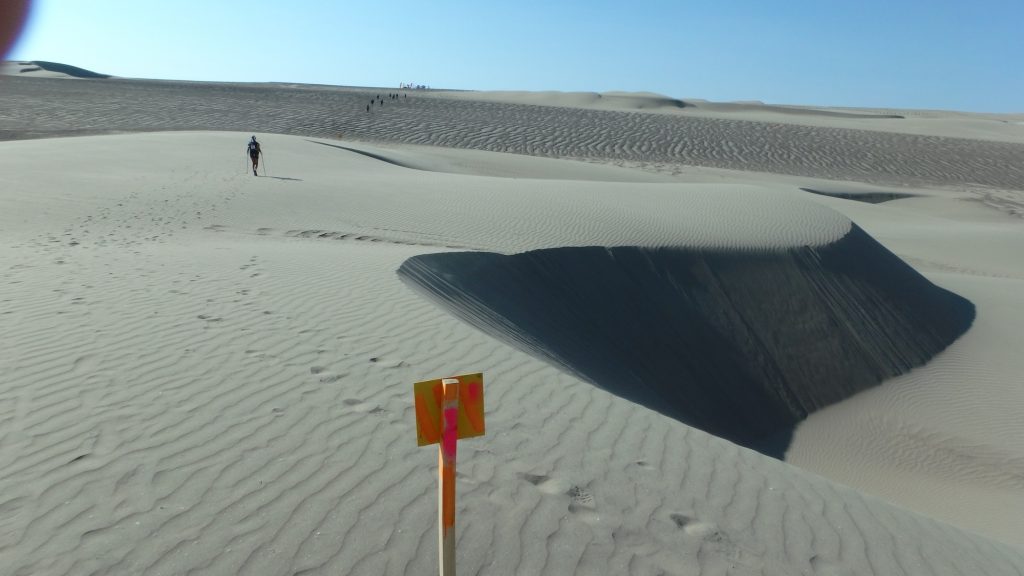
What else do you need ?
Looking at my Peru 2017 photos, it seems I have split the rest loosely into 3 categories: software, hardware and the rest.
Software:
Going clockwise from the top left: spare shirt, down jacket (top of sleeping bag), bottom of sleeping bag, inflatable sleeping mat, towel, gaiters and long trousers.

Hardware:
Lots of stuff. See if you can spot: toilet roll (x2), survival blanket, lighter, usb cable, compass, signal mirror, sticky tape, head torch, pen, camera, cable ties and safety pins, spare battery and chip for camera, spare head torch batteries, knife, mp3 player, head phones, pen, usb charger, spare torch, needle and thread.
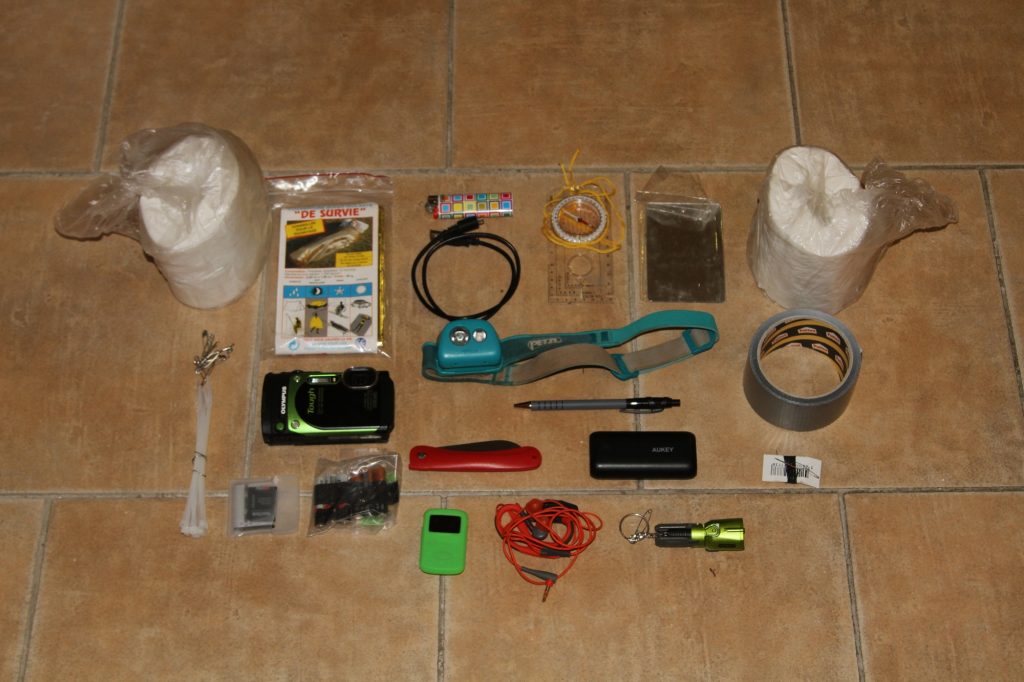
The Rest:
Then add to this all the health stuff. This covers tooth brush and paste, sun screen, various tummy pills, antiseptic gel, nail clippers and blister plasters. The latter were new for Peru as in Morocco I had all sort of blisters which had to be treated by the on site medical team. I figured for Peru I would manage them myself – big big mistake.
After the first day I had some tiny blisters under my feet. No problem – use the special blister plasters. On the next day, half way through the 42km stage, I had to suddenly stop with a massive sharp pain in my foot. After removing my shoe and sock I discovered that somehow sand had slipped its way under the plaster and was rubbing into the blister hole.
As I started to pull the plaster off disaster struck. The glue on the plaster was stronger than my skin so rather than the plaster coming off my skin, my skin came off my foot. In the end I had to use my knife to cut off the plaster/skin which unfortunately left me with a 2cm hole in my foot.
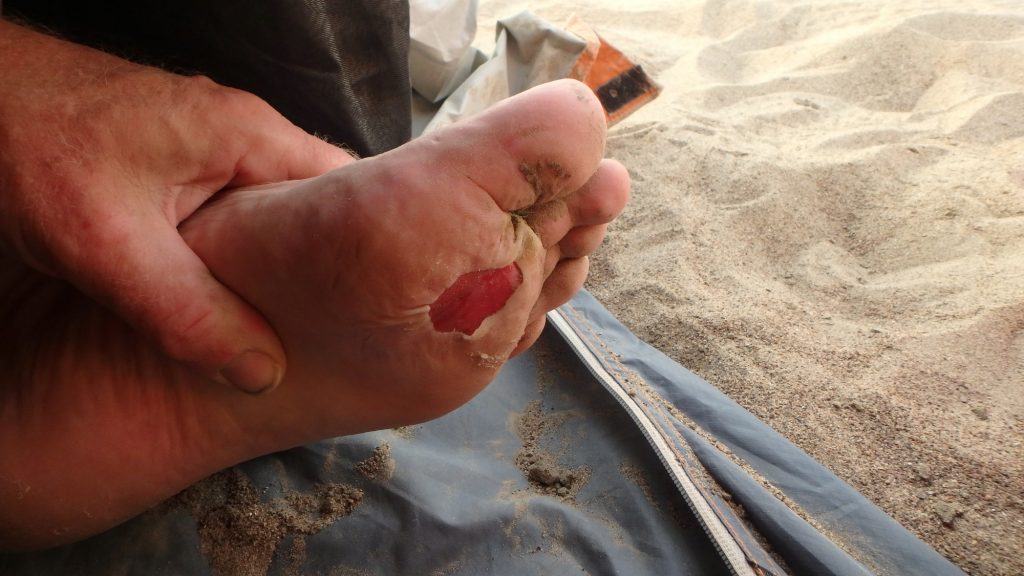
Just as I had completed my repair operation and repacked my bag, a 4×4 arrived out of nowhere. Seems I had been stationary so long that my satellite locator thingy had sent out an alert. Magic. I told them I was OK and off I limped. 20km later I arrived at the bivouac and went to the medical tent. Needless to say they had never seen anything quite like my foot before and this was only day 2. It’s amazing what you can get used to. I covered about 180km over the next 4 days trying to find the least painful way to jog. It was months before my foot was completely healed.

So that’s about everything I carried on the MDS. There are also the clothes I run in and my back pack etc but they are quite straight forward.
So That’s All ?
Yes, just put all that together and that’s all you need to complete the 7 day 250km Marathon des Sables. Apart from, of course, the question of training and I don’t just mean physical. Yes you can put on a heavy pack and jog around your area to your heart’s content to prepare your body but don’t forget your mind.
To reach the end of the MDS you have to be prepared to:
- Share a tent with 6 strangers for 8 days
- 8 days with no internet, no news and no Social Media(*)
- 8 days without sitting on a chair
- Be on your own(**) burning energy for 6 to 8 hours per day for 3 days
- Complete the long stage which could take over 24 hours
- Complete, probably your slowest ever, 42km marathon
- Party in the desert
- On the final day complete 10 to 20km back to civilization
- Don’t give up, otherwise the organisation will whisk you off to a hotel with air conditioning, swimming pool and room service.
At all times you have to remember you don’t have to do this. You have paid a ton of money for the experience so you had better enjoy it.
(*) Not sure about these days but back in 2017 there was a batch email system running in both Morocco and Peru. Each evening we could queue up and use one of the 20 or so little computers to compose a limited length email. These were then batch sent when the satellite comes around – or something. Replies are all printed out and delivered to your tent the next evening. The incoming emails were sent simply to the race numbers. A few of us received some fun messages of encouragement from people that had done the MDS in the past with the same number. I also received all sorts of odd messages from my odd friends but that’s another story. Thank you Mark.
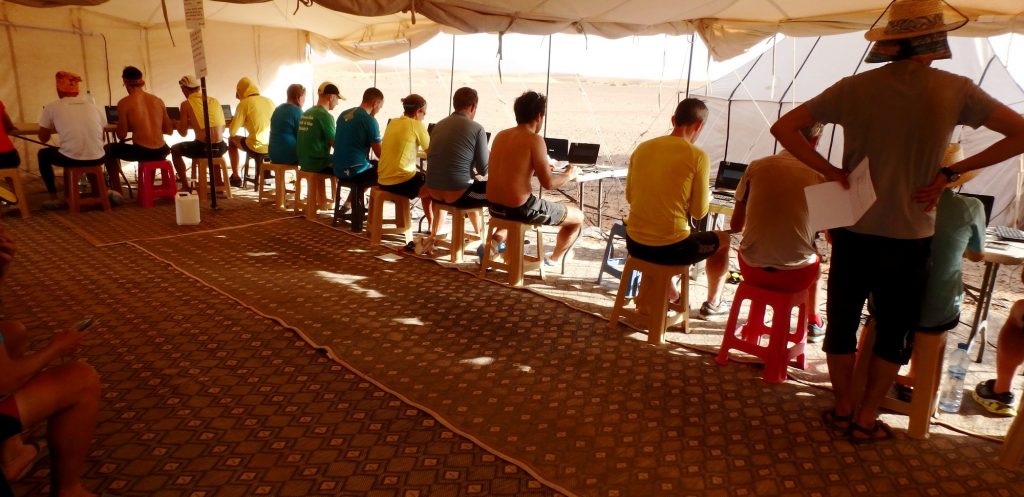
(**) I think I should qualify the “being on your own” bit during the stages. In Peru, with only 200 athletes, I was actually on my own. In Morocco, with 1,200 athletes, I was on my own in the same way you are on your own in a busy railway station. I felt that Peru made for a much better “adventure”.

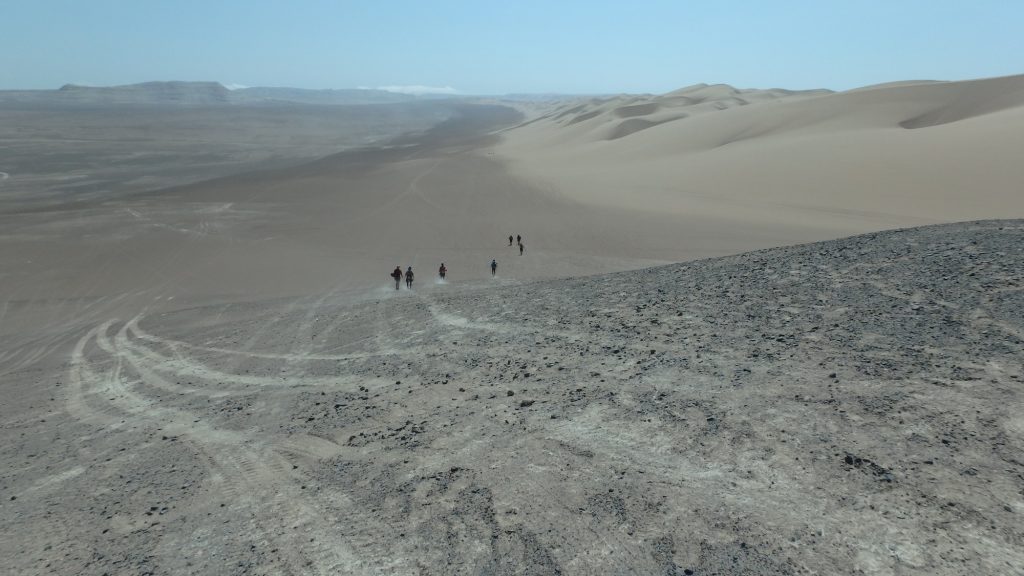
And Finally
Here is an official photo off me in full gear plodding along a rocky ridge in the 2017 Morocco MDS.
